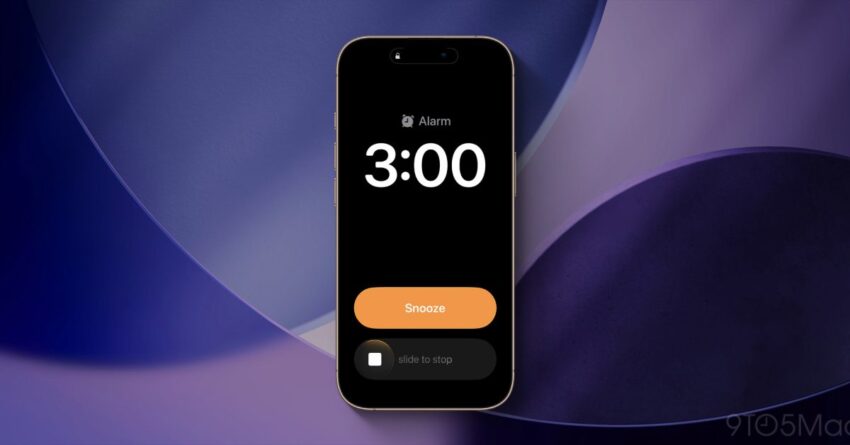
ios 26 1 beta 2 makes alarms Apple has introduced a significant update in its latest iOS 26.1 beta 2, aimed at enhancing user experience by making alarms more difficult to accidentally dismiss.
ios 26 1 beta 2 makes alarms
Overview of the Update
In the realm of mobile operating systems, user interface design plays a crucial role in ensuring that essential functions, such as alarms, are both effective and user-friendly. With the release of iOS 26, Apple took a step toward improving the alarm experience by redesigning the alarm screen. This redesign featured much larger buttons compared to previous iterations, making it easier for users to interact with their alarms. However, the company has recognized that further enhancements are necessary to reduce accidental dismissals, which can lead to missed appointments or important reminders.
The latest beta version, iOS 26.1 beta 2, introduces a new feature: a ‘Slide to stop’ gesture for dismissing alarms. This change aims to provide a more deliberate action for users when they wish to turn off their alarms, thereby minimizing the chances of unintentional dismissals. This update reflects Apple’s ongoing commitment to refining user experience and addressing feedback from its user base.
Details of the New Feature
Gesture Mechanics
The ‘Slide to stop’ gesture is designed to require a more intentional action compared to simply tapping a button. Users will now need to slide their finger across the screen to dismiss an alarm, which is a more tactile and deliberate action. This modification is particularly beneficial for those who may have previously found it too easy to accidentally tap the wrong button, especially in a groggy state upon waking.
This gesture aligns with similar features found in other applications and devices, where swiping or sliding has become a common method for confirming actions. By implementing this familiar gesture, Apple not only enhances usability but also ensures that users are more engaged when interacting with their alarms.
Visual Design Changes
In addition to the new gesture, the visual design of the alarm screen remains consistent with the larger buttons introduced in iOS 26. This design choice was made to improve accessibility and ease of use, particularly for individuals with varying levels of dexterity. The larger buttons allow users to interact with the alarm interface more comfortably, reducing the likelihood of mis-taps.
The overall aesthetic of the alarm screen continues to reflect Apple’s design philosophy, emphasizing simplicity and clarity. The combination of larger buttons and the new slide gesture creates a cohesive user experience that prioritizes functionality without sacrificing style.
Implications for Users
Reducing Accidental Dismissals
One of the most significant implications of this update is the potential reduction in accidental dismissals of alarms. Many users have experienced the frustration of waking up late due to inadvertently turning off their alarms. The introduction of the ‘Slide to stop’ gesture serves as a safeguard against this common issue, allowing users to feel more confident that their alarms will function as intended.
This change is particularly relevant for individuals who rely heavily on alarms for their daily routines, such as students, professionals, and anyone with a busy schedule. By minimizing the risk of accidental dismissals, Apple is effectively supporting users in managing their time more effectively.
Feedback from Users
Apple has a history of incorporating user feedback into its product updates, and this latest change appears to be no exception. Many users have expressed their concerns regarding the ease of dismissing alarms in previous versions of iOS. The introduction of the new gesture indicates that Apple is listening to its customer base and actively working to address their needs.
In forums and social media platforms, users have shared their experiences with alarm dismissals, highlighting the need for a more robust solution. The ‘Slide to stop’ feature is a direct response to these concerns, showcasing Apple’s commitment to enhancing user satisfaction.
Comparative Analysis with Other Operating Systems
Android and Alarm Features
When comparing iOS to Android, it is evident that both operating systems have their unique approaches to alarm functionality. Android devices often offer a variety of alarm customization options, including different sounds, snooze durations, and even integration with smart home devices. However, the ease of dismissing alarms can vary significantly between different Android manufacturers and models.
Apple’s decision to implement a more deliberate gesture for alarm dismissal may set a new standard within the iOS ecosystem, potentially influencing how alarm features are designed in future Android updates. As users increasingly seek intuitive and user-friendly interfaces, the pressure is on all operating systems to adapt and innovate.
Industry Standards and User Expectations
The introduction of the ‘Slide to stop’ gesture also reflects broader industry trends toward enhancing user experience through thoughtful design. As technology evolves, user expectations continue to rise. Consumers now expect devices to be not only functional but also intuitive and responsive to their needs.
By adopting a more deliberate gesture for alarm dismissal, Apple is aligning itself with these industry standards while also setting a benchmark for competitors. This move could encourage other tech companies to reevaluate their alarm functionalities and consider similar enhancements to improve user satisfaction.
Future Prospects
Potential for Further Enhancements
As iOS 26.1 beta 2 continues to roll out, it remains to be seen whether this new feature will lead to additional enhancements in future updates. Apple has a history of iterating on its features based on user feedback and technological advancements. The introduction of the ‘Slide to stop’ gesture could pave the way for further refinements in alarm functionalities, such as customizable gestures or additional snooze options.
Moreover, as smart home technology becomes increasingly integrated into daily life, there may be opportunities for Apple to expand its alarm features to include compatibility with smart devices. For example, alarms could potentially trigger specific actions within a smart home ecosystem, such as adjusting lighting or starting a coffee maker, further enhancing the waking experience.
Community Reactions
The tech community has responded positively to the announcement of the new alarm feature. Many users have taken to social media to express their approval, noting that the change addresses a long-standing issue with alarm dismissals. The feedback has been overwhelmingly supportive, with users appreciating Apple’s proactive approach to improving user experience.
However, some users remain skeptical about the effectiveness of the new gesture, questioning whether it will truly reduce accidental dismissals. As the beta testing phase continues, it will be crucial for Apple to gather data on user interactions with the new feature to assess its impact accurately.
Conclusion
The introduction of the ‘Slide to stop’ gesture in iOS 26.1 beta 2 marks a significant step forward in enhancing the alarm experience for iPhone users. By requiring a more deliberate action to dismiss alarms, Apple aims to reduce the frequency of accidental dismissals, thereby helping users better manage their time. This update not only reflects Apple’s commitment to user feedback but also sets a new standard for alarm functionalities across mobile operating systems.
As the beta phase progresses, it will be interesting to see how users adapt to this new feature and whether it leads to further innovations in alarm technology. For now, iOS 26.1 beta 2 stands as a testament to Apple’s dedication to refining user experience and addressing the needs of its diverse user base.
Source: Original report
Was this helpful?
Last Modified: October 7, 2025 at 12:44 am
0 views















